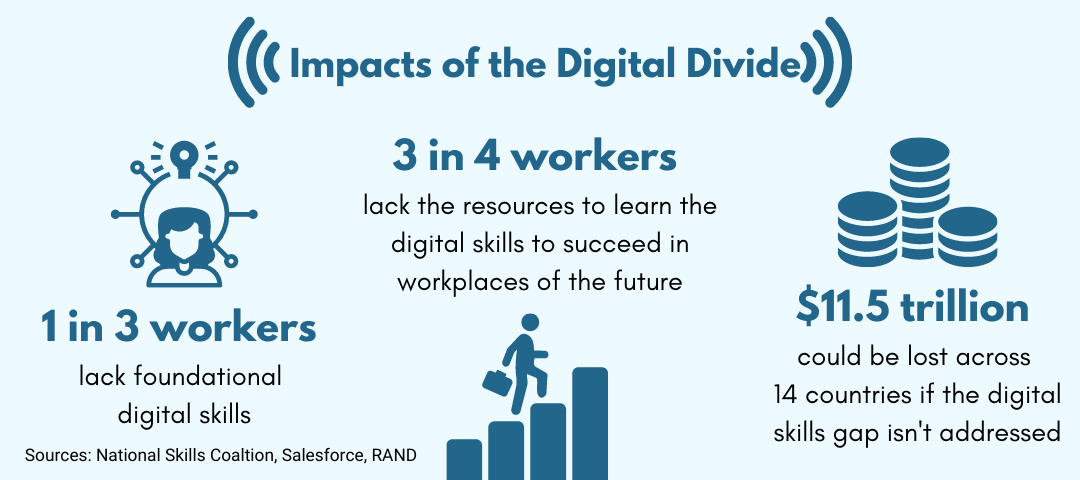However, during the past two years, COVID-19 highlighted and accelerated two trends which, together, are bringing to light a third element of the digital divide: those who lack sufficient digital skills to fully participate in today’s digital society.
- First, COVID accelerated the previously existing trends toward remote work, online learning/digital content, telehealth, online banking, etc; and
- COVID magnified the recognition of the digital skills gap—in schools, workplaces and especially under-served populations.
As a result, it is becoming more widely accepted that efforts to close the digital divide must include not only improving access to devices and broadband access, but also ensuring that target populations gain the digital skills to effectively participate in the digital world.
A study published by the National Skills Coalition indicated that 1 in 3 workers (aged 16-64) lack foundational digital skills. And the gap is projected to only increase: World Economic Forum estimated that, over a five year period, 85 million jobs worldwide would be eliminated due to the rise of artificial intelligence and automation. These jobs tend to be low-skill jobs such as data entry specialists, bookkeepers, secretaries and administrative assistants, and stock-keeping clerks. Meanwhile, the same report predicts that over the same period, 97 million new jobs will be created, in fields such as data analysis, machine learning, digital marketing and process automation.
Additionally, Salesforce recently published a Digital Skills Index, based on survey results of 23,000+ workers across 19 countries. Some key findings:
- A majority of workers say they lack the digital skills to prepare them for the future
- Workers scored an average of 33 points out of 100 on the Digital Skills Readiness Index
- Nearly 3 out of 4 respondents say they aren’t equipped with the resources needed to learn the digital skills they need to succeed in the current and future workplace
- Only 31% of Gen Z respondents (the first truly digital native generation) feel “very equipped” for a digital-first job right now. A low percentage of Gen Z workers believe they have “advanced” digital skills in areas like coding (20%), data encryption and cybersecurity (18%) and AI (7%)
- For Baby Boomers, only 17% believe they are “very equipped” for digital-first employment.
A recent RAND report highlights that the digital skills gap comes with high economic cost: 14 G20 countries could miss out on an estimated $11.5 trillion cumulative GPD growth if the digital skills gap isn’t addressed.
The good news is that corporations, foundations and governments (federal, state and local) are recognizing the imperative for ensuring our population has the necessary resources—and skills—to participate in the increasingly digital world. We are seeing many recent examples of this commitment to addressing the digital skills gap, not the least of which is $2.8 billion in federal funds to the Digital Equity Act. We at Learning.com are fortunate to be able to work with many partners in this area.
For 20 years, Learning.com has worked with school districts and states around the nation to provide digital skills education to K-12 students. Our digital curriculum spans computer fundamentals and keyboarding, which are essential in nearly every facet of school and work now, to more advanced skills like data analysis and coding, that can lead directly into digital-first careers. We know that ensuring that students from all kinds of districts – rural and urban, large and small – get an early start on developing these essential skills, means they will gain access to full participation in the digital economy. And we’re looking forward to working together with others to close the current digital divide once and for all.

Keith Oelrich
CEO
Keith Oelrich joined Learning.com as CEO in 2012. A pioneer in the K-12 online education market since 2000, Keith has served as CEO of several companies which have collectively provided K-12 online education programs to thousands of districts, tens of thousands of schools and millions of students and their families.
Further Reading
Teaching Students to Identify Cyberbullying: A Guide for K-12 Educators
In today’s interconnected world, technology is becoming an increasingly integral part of children’s lives, offering countless opportunities for...
Integrating AI Into Your Curriculum for K-12 Education
Find out how AI curriculum can transform K-12 education, boosting engagement and fostering critical thinking. Get started with essential insights and examples.
Teaching AI: Ethical Considerations for High School Students
Teaching AI in high schools comes with ethical questions. Discover key considerations for educators introducing AI to young learners





